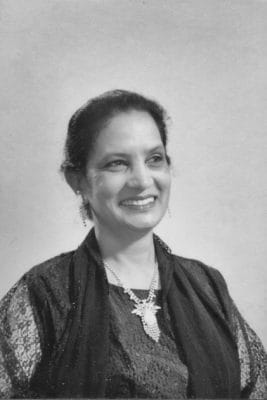Click here to connect with Surinder on LinkedIn
As a young girl, I watched my mother grinding spices to make garam masala, in much the same way as her mother and generations before had done, in the time-honoured tradition of squatting down at the heavy black mortar and hand-grinding with the long wooden pestle.

I have taught my sons and daughter to cook all of our Punjabi dishes.
As I grew up, my mother taught me the specific blend and combinations of the spices she used to make our Indian food and the only change she made to her garam masala was the use of a small electric coffee-grinder. All other ingredients were fresh and carefully added to make delicious North Indian Punjabi dishes.
Today, Pure Punjabi products are made by hand with loving care in small batches.
I learned household skills at an early age, helping my mother in her guest house, running to and fro from the guest dining room to the kitchen, where she mainly prepared English dishes for our English guests. Then when the guests had eaten and the dishes were cleared, we would eat our meals – sometimes English, but more often, traditional Punjabi dishes, which weren’t on the guest house menu.

My mother was a kind and lovely lady and she spent hours cooking and preparing dishes from her childhood and these she taught to me with love and patience. At the time I didn’t fully appreciate the heritage and skills she was passing down to me but by the time I was 11 years old, I knew how to make or prepare sabjhi, (vegetable dishes), dhal, (lentil or pulses), chicken dishes, roti, (chapatis),Parathas, (fried chappatis), dhai (yogurt) and ghee and much more.
My mother
I learned that the basis of Punjabi cooking was Garam Masala and my mother instructed me on the exact proportions of each spice that she used in the blend that she had learned from her mother and grandmother. All of these lessons I put into daily practice as I had to run home from school at 4p.m. each school night to start preparing an Indian meal to be ready by 6p.m. three to four nights of the week. Everything had to be prepared from scratch, using only fresh ingredients, as during the 70’s the availability of dried and powdered or mass-produced food was not on supermarket shelves as it is today.
Saturdays were spent food shopping in the mornings, often in Charlotte Street Market in Portsmouth, then home to start experimenting with English dishes and cooking. I learned to bake pastry and prepare English food, thanks to Delia Smith and Katie Stewart cookbooks.
Indian food cooked at home, without excess of oil, is one of the healthiest ways to eat. The food is satisfying and warming and you never feel deprived. The health benefits are huge and everything is prepared from nature!
To learn how to cook healthy, yet satisfying food, we run Indian Cookery for Weight Loss Workshops –
http://www.surinderspersonaltraining.com/weight-loss-cookery-workshops/
The Garam Masala recipe that my mother handed down to me has now been passed to Safia, as well as my two sons and we stand by preparing her recipe in the time-honoured tradition, just the way I was taught.
